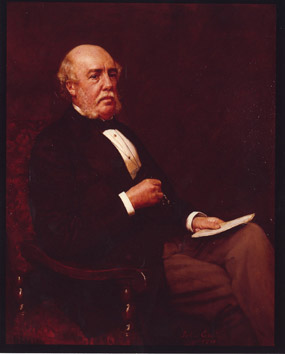- William Henry Barlow
Infobox Engineer

image_width = 150px
caption = William Henry Barlow
name = William Henry Barlow
nationality = English
birth_date = 1812
birth_place = Charlton,London
death_date = 1902
death_place =
education =
spouse =
parents =
children =
discipline = Civil
institutions =Institution of Civil Engineers (president)
practice_name =
significant_projects =Clifton Suspension Bridge ,St Pancras railway station ,
significant_design =Barlow rail
significant_advance =
significant_awards =William Henry Barlow (1812-1902) was an English
civil engineer of the 19th century, particularly associated withrailway engineering projects.Early life and education
Born in Charlton in south-east
London , the son of an engineer and mathematician (ProfessorPeter Barlow , who taught at theRoyal Military Academy inWoolwich ), William Barlow grew up close toWoolwich Dockyard and his formative years as an engineer were spent studying with his father and working in the Dockyard’s machinery department.Career
He then spent six years working as an engineer in
Constantinople ,Turkey , helping build an ordnance factory on behalf ofHenry Maudslay ’s machine tool company (and working on somelighthouse s in theBosphorus ), before returning to take up a post as assistant engineer on the Manchester and Birmingham (London and North-Western) Railway (1838), after which he joined theMidland Railway (1842). He formed his own consulting practice in 1857, but remained a consultant for the Midland Railway.An active member of theInstitution of Civil Engineers , Barlow became involved in several ICE initiatives, including the design of the building used for theGreat Exhibition of 1851 , and the realisation of theClifton Suspension Bridge in 1864 after the death of the celebratedIsambard Kingdom Brunel in 1859.As chief engineer for the Midland Railway, Barlow was responsible for sections of the main railway lines between London and the east Midlands. The route’s most famous landmark is the train shed at its London terminus:St Pancras Station (1864-68), which Barlow designed withRowland Mason Ordish and William Henry Le Feuvre. This has an arched cast iron and steel canopy with a 74 m (243 ft) span – then the longest of its kind in the world. The canopy is 213 m (700 ft) long and about 30 m (100 ft) high.George Gilbert Scott designed the hotel in front of the shed.His brother
Peter W. Barlow was also a noted engineer, whose major contributions included new developments intunnelling shield s in conjunction withJames Henry Greathead – a pupil of William Barlow’s during the late 1860s.Barlow was a Fellow of the Royal Society from 1850, and was elected as president of the Institution of Civil Engineers in 1879.Citation | first = Garth | last = Watson| title = The Civils | publisher = London: Thomas Telford Ltd | page = 251
year = 1988 | isbn = 0-727-70392-7]Tay Bridge Disaster
His leading role in the profession led to his appointment as a commissioner of the
Board of Trade Inquiry that investigated the disastrous failure of the railwaybridge across theRiver Tay nearDundee in 1879 (theTay Rail Bridge Disaster). The centre of the bridge collapsed in a storm on the night of December 28th, 1879, and an express train fromEdinburgh was on this part of the bridge when it fell. There were at least 75 victims, including all the passengers and crew, 29 of whose bodies were never recovered.He sat with
Hume Rothery andColonel Yolland , co-authoring one of the final reports with Yolland. They concluded that the original Tay bridge had been "badly designed, badly built and badly maintained". The old bridge had usedcast iron columns reinforced bywrought iron tie bars, but the connections were cast iron lugs. They were placed under tension and deteriorated during the short life of the structure, loosening and cracking, until they failed catastrophically on the night of the disaster. The entire centre section of the bridge collapsed, leaving a gap of nearly half-a-mile in the 2 mile long bridge. The thirteen towers supporting the massive girders which held the railway track had failed in sequence owing to several design flaws in their structure. The report caused a sensation at the time, and the engineering profession came under severe attack in the press.William Barlow led the design of the replacement bridge (1882-87) with his son Crawford Barlow. They used massive
monocoque piers to support a double railway track, and made fromwrought iron andsteel . The old brick and masonry piers from the first bridge built byThomas Bouch were retained asbreakwater s for the new piers upstream. They can still be seen today as a forlorn reminder of the tragedy of 1879.During the same period, he also helped check the designs for the Forth Bridge, west of
Edinburgh .William Barlow lived in Charlton at Highcombe, 145 Charlton Road, Greenwich, London SE7 (
blue plaque ).Barlow rail
Barlow invented and patented the
Barlow rail , a type of railway rail in 1849. [ [http://www.britsattheirbest.com/ingenious/ii_19th_century_1855.htm Brits at Their Best science timeline] ] This rail was very broad, with an inverted V shape and was intended to be laid straight onto ballast, without the need for sleepers. [ [http://www.penmorfa.com/Conwy/eight.htm Conwy Valley Line] ] However it had a tendency to lose its gauge and was soon replaced. [ [http://www.glamorganwalks.com/local_features_mid.htm Glamorgan Walks - Aberdare] ]Bibliography
* Peter R. Lewis, "Beautiful Railway Bridge of the Silvery Tay: Reinvestigating the Tay Bridge Disaster of 1879", Tempus, 2004, ISBN 0-7524-3160-9.
*Charles McKean "Battle for the North: The Tay and Forth bridges and the 19th century railway wars" Granta, 2006, ISBN 1-86207-852-1
* John Rapley, "Thomas Bouch : the builder of the Tay Bridge", Stroud : Tempus, 2006, ISBN 0-7524-3695-3
* PR Lewis, "Disaster on the Dee: Robert Stephenson's Nemesis of 1847", Tempus Publishing (2007) ISBN 978 0 7524 4266 2External links
* [http://en.structurae.de/persons/data/index.cfm?id=d000240 Biography of Barlow at Structurae]
* [http://www.victorianweb.org/art/architecture/pancras/18.html Barlow's train shed]References
s-start s-npo|pro s-bef|before=
John Frederick Bateman s-ttl|title=President of theInstitution of Civil Engineers
years=December 1879 – December 1880 s-aft|after=James Abernethy end
Wikimedia Foundation. 2010.
